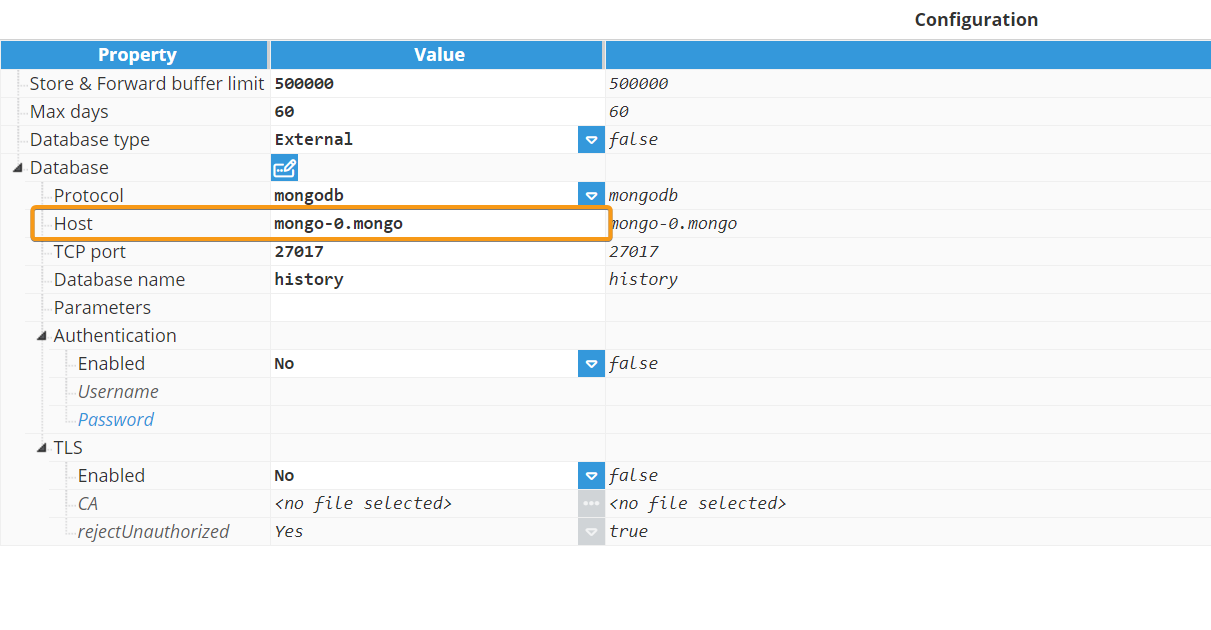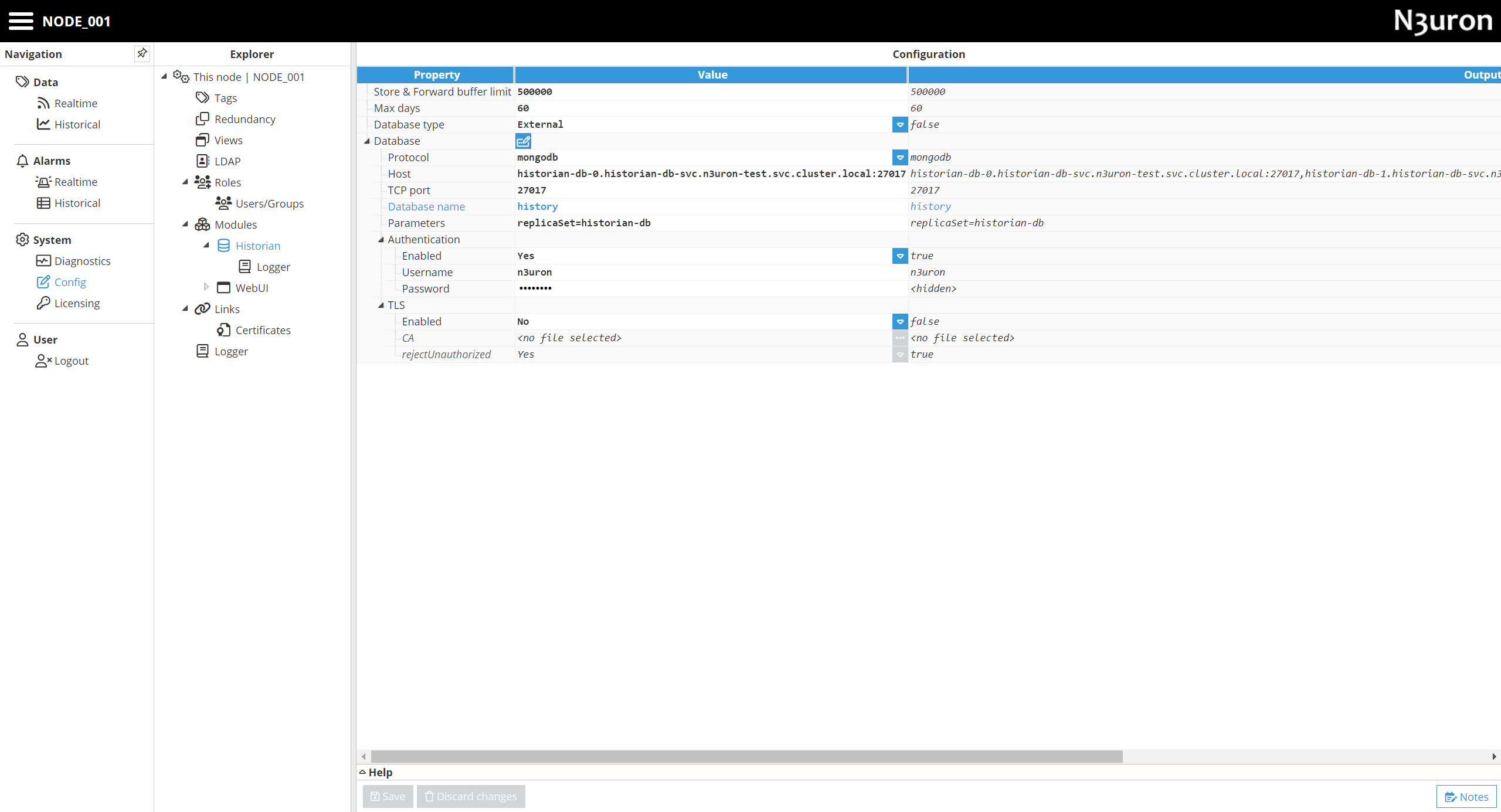Kubernetes is an open-source system for automating the deployment, scaling, and management of containerized applications.
Helm chart
N3uron is available as a Helm chart to streamline deployments in Kubernetes:
Step 1: Add the N3uron Helm repository:
helm repo add n3uron https://dl.n3uron.com/helm-chartsStep 2: Deploy N3uron:
The N3uron Helm chart supports two types of deployment: standalone, for deploying a single N3uron instance, and redundant, for deploying two N3uron instances with high availability and fault tolerance.
The following command deploys N3uron in standalone mode.
helm install n3uron n3uron/n3uron --set deploymentMode=standalone,adminPassword=n3uron,userPassword=n3uronNAME: n3uron
LAST DEPLOYED: Thu Dec 5 16:32:42 2024
NAMESPACE: default
STATUS: deployed
REVISION: 1Step 3: Access the N3uron WebUI:
kubectl get allNAME READY STATUS RESTARTS AGE
pod/n3uron-0 1/1 Running 0 16s
NAME TYPE CLUSTER-IP EXTERNAL-IP PORT(S) AGE
service/kubernetes ClusterIP 10.96.0.1 <none> 443/TCP 121d
service/n3uron-webui ClusterIP 10.104.106.192 <none> 8003/TCP 17s
NAME READY AGE
statefulset.apps/n3uron 1/1 17sEnable port forwarding:
kubectl port-forward pod/n3uron-0 8003:8003 Now the N3uron WebUI is accesible at http://localhost:8003
Standalone deployment
Deploy a single N3uron instance to Kubernetes.
Step 1: Create a secret to store the credentials to access the N3uron WebUI.
# n3uron-credentials.yaml
apiVersion: v1
kind: Secret
metadata:
name: n3uron-credentials
type: Opaque
stringData:
admin-password: <secure-password>
user-password: <other-secure-password>kubectl apply -f n3uron-credentials.yamlStep 2: Create a StatefulSet to deploy N3uron with persistent storage.
# n3uron-statefulset.yaml
apiVersion: apps/v1
kind: StatefulSet
metadata:
name: n3uron
spec:
serviceName: n3uron
selector:
matchLabels:
app: n3uron
template:
metadata:
labels:
app: n3uron
spec:
containers:
- name: n3uron
image: n3uronhub/n3uron:v1.21.13
env:
- name: HOSTNAME
value: n3uron-k8s-01 # Set the hostname for licensing
- name: ADMIN_PASSWORD
valueFrom:
secretKeyRef:
name: n3uron-credentials
key: admin-password
- name: USER_PASSWORD
valueFrom:
secretKeyRef:
name: n3uron-credentials
key: user-password
volumeMounts:
- name: n3-config
mountPath: /opt/n3uron/config
subPath: config
- name: n3-data
mountPath: /opt/n3uron/data
- name: n3-log
mountPath: /opt/n3uron/log
- name: n3-licenses
mountPath: /opt/n3uron/licenses
securityContext:
capabilities:
# The CAP_SYS_ADMIN capability is required to enforce a static hostname
# inside the container, otherwise licensing may not work.
add: ["CAP_SYS_ADMIN"]
ports:
- containerPort: 8003
volumeClaimTemplates:
- metadata:
name: n3-config
spec:
accessModes: ["ReadWriteOnce"]
resources:
requests:
storage: 1Gi
- metadata:
name: n3-data
spec:
accessModes: ["ReadWriteOnce"]
resources:
requests:
storage: 10Gi
- metadata:
name: n3-log
spec:
accessModes: ["ReadWriteOnce"]
resources:
requests:
storage: 5Gi
- metadata:
name: n3-licenses
spec:
accessModes: ["ReadWriteOnce"]
resources:
requests:
storage: 1Gikubectl apply -f n3uron-statefulset.yamlStep 3: Verify the deployment has been successful:
kubectl get allThere should be a running pod named n3uron-0
NAME READY STATUS RESTARTS AGE
pod/n3uron-0 1/1 Running 0 75s
NAME TYPE CLUSTER-IP EXTERNAL-IP PORT(S) AGE
service/kubernetes ClusterIP 10.96.0.1 <none> 443/TCP 79m
NAME READY AGE
statefulset.apps/n3uron 1/1 75sStep 4: Access the N3uron WebUI using port forwarding, with the following command we can access port 8003 in the N3uron container from our machine at port 8003, after running the command you can navigate to http://localhost:8003
kubectl port-forward pod/n3uron-0 8003:8003Standalone deployment with Historian
Deploy a single N3uron instance with a MongoDB database for Historian.
Step 1: Create a secret to store the credentials to access the N3uron WebUI.
# n3uron-credentials.yaml
apiVersion: v1
kind: Secret
metadata:
name: n3uron-credentials
type: Opaque
stringData:
admin-password: <secure-password>
user-password: <other-secure-password>kubectl apply -f n3uron-credentials.yamlStep 2: Create a StatefulSet to deploy N3uron with persistent storage.
# n3uron-statefulset.yaml
apiVersion: apps/v1
kind: StatefulSet
metadata:
name: n3uron
spec:
serviceName: n3uron
selector:
matchLabels:
app: n3uron
template:
metadata:
labels:
app: n3uron
spec:
containers:
- name: n3uron
image: n3uronhub/n3uron:v1.21.13
env:
- name: HOSTNAME
value: n3uron-k8s-01 # Set the hostname for licensing
- name: ADMIN_PASSWORD
valueFrom:
secretKeyRef:
name: n3uron-credentials
key: admin-password
- name: USER_PASSWORD
valueFrom:
secretKeyRef:
name: n3uron-credentials
key: user-password
volumeMounts:
- name: n3-config
mountPath: /opt/n3uron/config
subPath: config
- name: n3-data
mountPath: /opt/n3uron/data
- name: n3-log
mountPath: /opt/n3uron/log
- name: n3-licenses
mountPath: /opt/n3uron/licenses
securityContext:
capabilities:
# The CAP_SYS_ADMIN capability is required to enforce a static hostname
# inside the container, otherwise licensing may not work.
add: ["CAP_SYS_ADMIN"]
ports:
- containerPort: 8003
volumeClaimTemplates:
- metadata:
name: n3-config
spec:
accessModes: ["ReadWriteOnce"]
resources:
requests:
storage: 1Gi
- metadata:
name: n3-data
spec:
accessModes: ["ReadWriteOnce"]
resources:
requests:
storage: 10Gi
- metadata:
name: n3-log
spec:
accessModes: ["ReadWriteOnce"]
resources:
requests:
storage: 5Gi
- metadata:
name: n3-licenses
spec:
accessModes: ["ReadWriteOnce"]
resources:
requests:
storage: 1Gikubectl apply -f n3uron-statefulset.yamlStep 3: Create a StatefulSet to deploy the MongoDB database required by Historian:
# mongodb-statefulset.yaml
apiVersion: apps/v1
kind: StatefulSet
metadata:
name: mongo
spec:
selector:
matchLabels:
app: mongo
serviceName: mongo
template:
metadata:
labels:
app: mongo
spec:
containers:
- name: mongo
image: mongo:8
ports:
- containerPort: 27017
volumeMounts:
- name: data
mountPath: /data/db
volumeClaimTemplates:
- metadata:
name: data
spec:
accessModes: ["ReadWriteOnce"]
resources:
requests:
storage: 10Gikubectl apply -f mongo-statefulset.yamlStep 4: Create a Service to allow access to MongoDB from N3uron:
# mongodb-svc.yaml
apiVersion: v1
kind: Service
metadata:
name: mongo
namespace: n3uron-test
spec:
clusterIP: None
selector:
app: mongo
ports:
- port: 27017
targetPort: 27017kubectl apply -f mongo-svc.yamlStep 5: Verify that all resources have been created.
kubectl get allNAME READY STATUS RESTARTS AGE
pod/mongo-0 1/1 Running 1 (8m4s ago) 51m
pod/n3uron-0 1/1 Running 2 (8m ago) 20h
NAME TYPE CLUSTER-IP EXTERNAL-IP PORT(S) AGE
service/kubernetes ClusterIP 10.96.0.1 <none> 443/TCP 21h
service/mongo ClusterIP None <none> 27017/TCP 51m
NAME READY AGE
statefulset.apps/mongo 1/1 51m
statefulset.apps/n3uron 1/1 20hStep 4: Access the N3uron WebUI using port forwarding, with the following command we can access port 8003 in the N3uron container from our machine at port 8003, after running the command you can navigate to http://localhost:8003
kubectl port-forward pod/n3uron-0 8003:8003Step 6: Verify the deployment has been successful:
kubectl get all -n n3uron-testThere should be a Pod named n3uron-0
NAME READY STATUS RESTARTS AGE
pod/n3uron-0 1/1 Running 0 75s
NAME TYPE CLUSTER-IP EXTERNAL-IP PORT(S) AGE
service/kubernetes ClusterIP 10.96.0.1 <none> 443/TCP 79m
NAME READY AGE
statefulset.apps/n3uron 1/1 75sStep 7: Access the N3uron WebUI using port forwarding, with the following command we can access port 8003 at the N3uron container from our machine at port 8003, after running the command you can navigate to http://localhost:8003
kubectl port-forward pod/n3uron-0 8003:8003 -n n3uron-testStep 8: Create a file mongo-statefulset.yaml with the following content:
apiVersion: apps/v1
kind: StatefulSet
metadata:
name: mongo
namespace: n3uron-test
spec:
selector:
matchLabels:
app: mongo
serviceName: "mongo"
template:
metadata:
labels:
app: mongo
spec:
containers:
- name: mongo
image: mongo:8
ports:
- containerPort: 27017
volumeMounts:
- name: data
mountPath: /data/db
volumeClaimTemplates:
- metadata:
name: data
spec:
accessModes: ["ReadWriteOnce"]
resources:
requests:
storage: 10GiStep 9: Apply the manifest to deploy MongoDB:
kubectl apply -f mongo-statefulset.yamlStep 10: Create a file mongo-svc.yaml with the following content:
apiVersion: v1
kind: Service
metadata:
name: mongo
namespace: n3uron-test
spec:
clusterIP: None
selector:
app: mongo
ports:
- port: 27017
targetPort: 27017Step 11: Deploy the service manifest to Kubernetes, this will create an endpoint to access the MongoDB database from N3uron.
kubectl apply -f mongo-svc.yamlStep 12: Verify that all resources have been created.
kubectl get all -n n3uron-testThere is a new pod mongo-0 and a service mongo.
NAME READY STATUS RESTARTS AGE
pod/mongo-0 1/1 Running 1 (8m4s ago) 51m
pod/n3uron-0 1/1 Running 2 (8m ago) 20h
NAME TYPE CLUSTER-IP EXTERNAL-IP PORT(S) AGE
service/kubernetes ClusterIP 10.96.0.1 <none> 443/TCP 21h
service/mongo ClusterIP None <none> 27017/TCP 51m
NAME READY AGE
statefulset.apps/mongo 1/1 51m
statefulset.apps/n3uron 1/1 20hHistorian configuration
To access the MongoDB database from the N3uron Historian module we need to select External as Database type and set the Host field to mongo-0.mongo, this address is constructed with the Pod name (mongo-0) and the Service name (mongo).

Redundant deployment with Historian (Replica Set)
Deploy two redundant N3uron instances with a MongoDB replica set for high availability.
Step 1: Create a new namespace for N3uron.
kubectl create namespace n3uron-testStep 2: Install the MongoDB Kubernetes Operator using Helm.
helm repo add mongodb https://mongodb.github.io/helm-charts
helm install community-operator mongodb/community-operator --namespace n3uron-testStep 3: Create a secret to securely store the credentials to access the N3uron WebUI. Put the following content in a file named n3uron-credentials.yaml then set the desired passwords.
apiVersion: v1
kind: Secret
metadata:
name: n3uron-credentials
namespace: n3uron-test
type: Opaque
stringData:
admin-password: <secure-password>
user-password: <other-secure-password>
mongo-password: <another-secure-password>Step 4: Apply the manifest to create the resource.
kubectl apply -f n3uron-credentials.yamlStep 5: Create a file named n3uron-statefulset.yaml with the following content:
apiVersion: apps/v1
kind: StatefulSet
metadata:
name: n3uron
namespace: n3uron-test
spec:
serviceName: "n3uron"
replicas: 2
selector:
matchLabels:
app: n3uron
template:
metadata:
labels:
app: n3uron
spec:
containers:
- name: n3uron
image: n3uronhub/n3uron:v1.21.13
env:
- name: HOSTNAME
valueFrom:
fieldRef:
fieldPath: metadata.name # Use the pod's name as the hostname for licensing
- name: ADMIN_PASSWORD
valueFrom:
secretKeyRef:
name: n3uron-credentials
key: admin-password
- name: USER_PASSWORD
valueFrom:
secretKeyRef:
name: n3uron-credentials
key: user-password
volumeMounts:
- name: n3-config
mountPath: /opt/n3uron/config
subPath: config
- name: n3-data
mountPath: /opt/n3uron/data
- name: n3-log
mountPath: /opt/n3uron/log
- name: n3-licenses
mountPath: /opt/n3uron/licenses
securityContext:
capabilities:
# The CAP_SYS_ADMIN capability is required to enforce a static hostname
# inside the container, otherwise licensing may not work.
add: ["CAP_SYS_ADMIN"]
ports:
- name: webui
containerPort: 8003
- name: redundancy
containerPort: 3002
volumeClaimTemplates:
- metadata:
name: n3-config
spec:
accessModes: ["ReadWriteOnce"]
resources:
requests:
storage: 1Gi
- metadata:
name: n3-data
spec:
accessModes: ["ReadWriteOnce"]
resources:
requests:
storage: 10Gi
- metadata:
name: n3-log
spec:
accessModes: ["ReadWriteOnce"]
resources:
requests:
storage: 5Gi
- metadata:
name: n3-licenses
spec:
accessModes: ["ReadWriteOnce"]
resources:
requests:
storage: 1GiStep 6: Apply the manifest to deploy N3uron:
kubectl apply -f n3uron-statefulset.yamlStep 7: Verify the deployment has been successful:
kubectl get all -n n3uron-testWe have the MongoDB operator deployed and two N3uron pods running, n3uron-0 and n3uron-1
NAME READY STATUS RESTARTS AGE
pod/mongodb-kubernetes-operator-558d9545b8-hn5kf 1/1 Running 0 2m29s
pod/n3uron-0 1/1 Running 0 10s
pod/n3uron-1 1/1 Running 0 8s
NAME READY UP-TO-DATE AVAILABLE AGE
deployment.apps/mongodb-kubernetes-operator 1/1 1 1 2m29s
NAME DESIRED CURRENT READY AGE
replicaset.apps/mongodb-kubernetes-operator-558d9545b8 1 1 1 2m29s
NAME READY AGE
statefulset.apps/n3uron 2/2 10sStep 8: Create a Service to allow the N3uron-to-N3uron communication required by the redundancy mode. Put the following definition in a file named n3uron-svc.yaml.
apiVersion: v1
kind: Service
metadata:
name: n3uron
namespace: n3uron-test
spec:
clusterIP: None
selector:
app: n3uron
ports:
- port: 3002
targetPort: redundancykubectl apply -f n3uron-svc.yamlStep 9: Create a custom MongoDBCommunity resource to deploy a MongoDB replica-set cluster. Save the content into mongodb-cluster.yaml.
apiVersion: mongodbcommunity.mongodb.com/v1
kind: MongoDBCommunity
metadata:
name: historian-db
namespace: n3uron-test
spec:
members: 3
type: ReplicaSet
version: "7.0.21"
security:
authentication:
modes: ["SCRAM"]
users:
- name: n3uron
db: history
passwordSecretRef:
name: n3uron-credentials
key: db-password
roles:
- name: userAdminAnyDatabase
db: history
- name: readWrite
db: history
scramCredentialsSecretName: n3uronStep 10: Apply the manifest to deploy the MongoDB replica-set cluster, it can take a few minutes to complete the deployment:
kubectl apply -f mongodb-cluster.yamlStep 11: Verify the deployment has been successful:
kubectl get all -n n3uron-testNow we have three pods of MongoDB already configured to run as a replica set: historian-db-0, historian-db-1 and historian-db-2.
NAME READY STATUS RESTARTS AGE
pod/historian-db-0 2/2 Running 0 2m28s
pod/historian-db-1 2/2 Running 0 96s
pod/historian-db-2 2/2 Running 0 64s
pod/mongodb-kubernetes-operator-558d9545b8-hn5kf 1/1 Running 1 28m
pod/n3uron-0 1/1 Running 0 17m
pod/n3uron-1 1/1 Running 0 17m
NAME TYPE CLUSTER-IP EXTERNAL-IP PORT(S) AGE
service/historian-db-svc ClusterIP None <none> 27017/TCP 6m47s
service/n3uron ClusterIP None <none> 3002/TCP 19m
NAME READY UP-TO-DATE AVAILABLE AGE
deployment.apps/mongodb-kubernetes-operator 1/1 1 1 28m
NAME DESIRED CURRENT READY AGE
replicaset.apps/mongodb-kubernetes-operator-558d9545b8 1 1 1 28m
NAME READY AGE
statefulset.apps/historian-db 3/3 2m28s
statefulset.apps/historian-db-arb 0/0 2m28s
statefulset.apps/n3uron 2/2 17mStep 12: Retrieve the connection string to access the MongoDB cluster. This data is stored in a Kubernetes secret created by the MongoDB operator with the name <metadata.name>-<auth-db>-<username> in our case is historian-db--n3uron
kubectl get secret historian-db-history-n3uron -n n3uron-test -o json{
"apiVersion": "v1",
"data": {
"connectionString.standard": "bW9uZ29kYjovL24zdXJvbjptdXlzZWNyZXRvQGhpc3Rvcmlhbi1kYi0wLmhpc3Rvcmlhbi1kYi1zdmMubjN1cm9uLXRlc3Quc3ZjLmNsdXN0ZXIubG9jYWw6MjcwMTcsaGlzdG9yaWFuLWRiLTEuaGlzdG9yaWFuLWRiLXN2Yy5uM3Vyb24tdGVzdC5zdmMuY2x1c3Rlci5sb2NhbDoyNzAxNyxoaXN0b3JpYW4tZGItMi5oaXN0b3JpYW4tZGItc3ZjLm4zdXJvbi10ZXN0LnN2Yy5jbHVzdGVyLmxvY2FsOjI3MDE3L2hpc3Rvcnk/cmVwbGljYVNldD1oaXN0b3JpYW4tZGImc3NsPWZhbHNl",
"connectionString.standardSrv": "bW9uZ29kYitzcnY6Ly9uM3Vyb246bXV5c2VjcmV0b0BoaXN0b3JpYW4tZGItc3ZjLm4zdXJvbi10ZXN0LnN2Yy5jbHVzdGVyLmxvY2FsL2hpc3Rvcnk/cmVwbGljYVNldD1oaXN0b3JpYW4tZGImc3NsPWZhbHNl",
...
},
"kind": "Secret",
...
}After decoding the content in base64 we get the connection strings in plain text:
{
"apiVersion": "v1",
"data": {
"connectionString.standard": "mongodb://n3uron:secure-passwd@historian-db-0.historian-db-svc.n3uron-test.svc.cluster.local:27017,historian-db-1.historian-db-svc.n3uron-test.svc.cluster.local:27017,historian-db-2.historian-db-svc.n3uron-test.svc.cluster.local:27017/history?replicaSet=historian-db&ssl=false",
"connectionString.standardSrv": "mongodb+srv://n3uron:secure-passwd@historian-db-svc.n3uron-test.svc.cluster.local/history?replicaSet=historian-db&ssl=false",
...
},
"kind": "Secret",
...
}Step 13: Access and configure each N3uron node with redundancy, see Redundancy.
To access the primary node WebUI:
kubectl port-forward pod/n3uron-0 8003:8003 -n n3uron-testTo access the backup node WebUI:
kubectl port-forward pod/n3uron-1 8003:8003 -n n3uron-testUse the n3uron-0.n3uron address as Host in the backup node configuration, if the connection is established successfuly you’ll see the text (Standby) in the System section.
.png)
Step 14: Configure the Historian module to use the MongoDB replicaset as database. In this example we’ll use the Standard connection string.
.png)
This is the resulting configuration for the Historian module:

At this point you’ll have a fault-tolerant and redundant N3uron deployment with a Historian database backed by multiple MongoDB replicas.